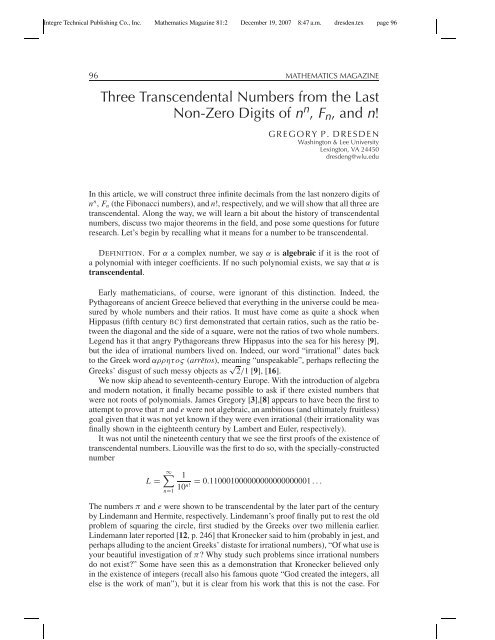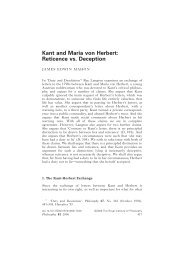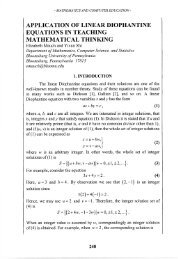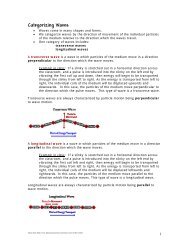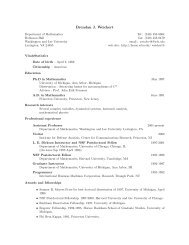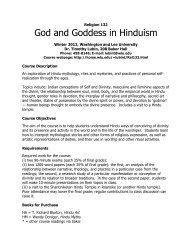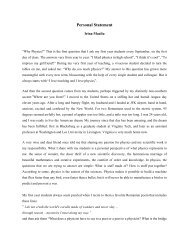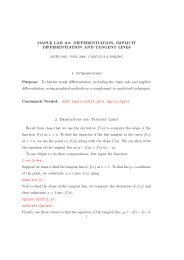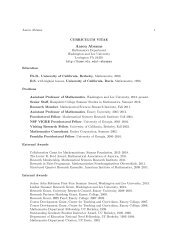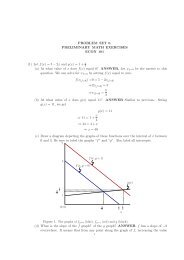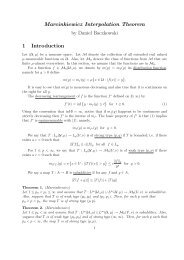Three Transcendental Numbers from the Last Non-Zero Digits of nn ...
Three Transcendental Numbers from the Last Non-Zero Digits of nn ...
Three Transcendental Numbers from the Last Non-Zero Digits of nn ...
Create successful ePaper yourself
Turn your PDF publications into a flip-book with our unique Google optimized e-Paper software.
Integre Technical Publishing Co., Inc. Ma<strong>the</strong>matics Magazine 81:2 December 19, 2007 8:47 a.m. dresden.tex page 96<br />
96 MATHEMATICS MAGAZINE<br />
<strong>Three</strong> <strong>Transcendental</strong> <strong>Numbers</strong> <strong>from</strong> <strong>the</strong> <strong>Last</strong><br />
<strong>Non</strong>-<strong>Zero</strong> <strong>Digits</strong> <strong>of</strong> n n , F n , and n!<br />
G R E G O R Y P . D R E S D E N<br />
Washington & Lee University<br />
Lexington, VA 24450<br />
dresdeng@wlu.edu<br />
In this article, we will construct three infinite decimals <strong>from</strong> <strong>the</strong> last nonzero digits <strong>of</strong><br />
n n , F n (<strong>the</strong> Fibonacci numbers), and n!, respectively, and we will show that all three are<br />
transcendental. Along <strong>the</strong> way, we will learn a bit about <strong>the</strong> history <strong>of</strong> transcendental<br />
numbers, discuss two major <strong>the</strong>orems in <strong>the</strong> field, and pose some questions for future<br />
research. Let’s begin by recalling what it means for a number to be transcendental.<br />
DEFINITION. For α a complex number, we say α is algebraic if it is <strong>the</strong> root <strong>of</strong><br />
a polynomial with integer coefficients. If no such polynomial exists, we say that α is<br />
transcendental.<br />
Early ma<strong>the</strong>maticians, <strong>of</strong> course, were ignorant <strong>of</strong> this distinction. Indeed, <strong>the</strong><br />
Pythagoreans <strong>of</strong> ancient Greece believed that everything in <strong>the</strong> universe could be measured<br />
by whole numbers and <strong>the</strong>ir ratios. It must have come as quite a shock when<br />
Hippasus (fifth century BC) first demonstrated that certain ratios, such as <strong>the</strong> ratio between<br />
<strong>the</strong> diagonal and <strong>the</strong> side <strong>of</strong> a square, were not <strong>the</strong> ratios <strong>of</strong> two whole numbers.<br />
Legend has it that angry Pythagoreans threw Hippasus into <strong>the</strong> sea for his heresy [9],<br />
but <strong>the</strong> idea <strong>of</strong> irrational numbers lived on. Indeed, our word “irrational” dates back<br />
to <strong>the</strong> Greek word αρρητoς (arrētos), meaning “unspeakable”, perhaps reflecting <strong>the</strong><br />
Greeks’ disgust <strong>of</strong> such messy objects as √ 2/1[9], [16].<br />
We now skip ahead to seventeenth-century Europe. With <strong>the</strong> introduction <strong>of</strong> algebra<br />
and modern notation, it finally became possible to ask if <strong>the</strong>re existed numbers that<br />
were not roots <strong>of</strong> polynomials. James Gregory [3],[8] appears to have been <strong>the</strong> first to<br />
attempt to prove that π and e were not algebraic, an ambitious (and ultimately fruitless)<br />
goal given that it was not yet known if <strong>the</strong>y were even irrational (<strong>the</strong>ir irrationality was<br />
finally shown in <strong>the</strong> eighteenth century by Lambert and Euler, respectively).<br />
It was not until <strong>the</strong> nineteenth century that we see <strong>the</strong> first pro<strong>of</strong>s <strong>of</strong> <strong>the</strong> existence <strong>of</strong><br />
transcendental numbers. Liouville was <strong>the</strong> first to do so, with <strong>the</strong> specially-constructed<br />
number<br />
L =<br />
∞∑<br />
n=1<br />
1<br />
10 n! = 0.110001000000000000000001 ...<br />
The numbers π and e were shown to be transcendental by <strong>the</strong> later part <strong>of</strong> <strong>the</strong> century<br />
by Lindema<strong>nn</strong> and Hermite, respectively. Lindema<strong>nn</strong>’s pro<strong>of</strong> finally put to rest <strong>the</strong> old<br />
problem <strong>of</strong> squaring <strong>the</strong> circle, first studied by <strong>the</strong> Greeks over two millenia earlier.<br />
Lindema<strong>nn</strong> later reported [12, p. 246] that Kronecker said to him (probably in jest, and<br />
perhaps alluding to <strong>the</strong> ancient Greeks’ distaste for irrational numbers), “Of what use is<br />
your beautiful investigation <strong>of</strong> π Why study such problems since irrational numbers<br />
do not exist” Some have seen this as a demonstration that Kronecker believed only<br />
in <strong>the</strong> existence <strong>of</strong> integers (recall also his famous quote “God created <strong>the</strong> integers, all<br />
else is <strong>the</strong> work <strong>of</strong> man”), but it is clear <strong>from</strong> his work that this is not <strong>the</strong> case. For
Integre Technical Publishing Co., Inc. Ma<strong>the</strong>matics Magazine 81:2 December 19, 2007 8:47 a.m. dresden.tex page 97<br />
VOL. 81, NO. 2, APRIL 2008 97<br />
a summary <strong>of</strong> <strong>the</strong> controversy over Kronecker’s words, see <strong>the</strong> article by Edwards [5,<br />
Essay 5.5].<br />
We note that even in <strong>the</strong> twenty-first century <strong>the</strong>re are many open questions about<br />
transcendental numbers. It’s not known if ζ(3) = 1 + 1 + 1 + 1 + · · · is transcendental,<br />
although ∑ Apéry did prove that it is irrational [14]. As for <strong>the</strong> Euler constant<br />
2 3 3 3 4 3<br />
γ = lim n 1<br />
n→∞ i=1<br />
− ln n, we do not yet know if it is even irrational, let alone<br />
i<br />
transcendental. For a fur<strong>the</strong>r discussion <strong>of</strong> recent work on transcendental numbers,<br />
Ribenboim in [13] provides an English summary <strong>of</strong> a 1983 historical overview by<br />
Waldschmidt [17]. See also Ribenboim’s extensive bibliography in [13, Chapter 10].<br />
Two Modern Theorems<br />
It is possible to prove that certain numbers (such as π and e) are transcendental by<br />
assuming <strong>the</strong>m to be algebraic and <strong>the</strong>n working towards a contradiction. Such pro<strong>of</strong>s<br />
are fairly complicated and involve a lot <strong>of</strong> auxiliary polynomials [7], [2]. Fortunately,<br />
<strong>the</strong>re exist several different characterizations <strong>of</strong> transcendental numbers that will prove<br />
to be much easier to work with. This first <strong>the</strong>orem is <strong>the</strong> result <strong>of</strong> <strong>the</strong> work <strong>of</strong> three<br />
ma<strong>the</strong>maticians over <strong>the</strong> first half <strong>of</strong> <strong>the</strong> twentieth century; it is restated slightly for<br />
convenience.<br />
THEOREM 1. (THUE,SIEGEL,ROTH) For α algebraic and ɛ> 0, <strong>the</strong>re exist only<br />
finitely many rational numbers p/q such that<br />
∣ α − p q ∣ < 1<br />
q . 2+ɛ<br />
Thus, if we can show that for some fixed ɛ> 0 <strong>the</strong>re are infinitely many such numbers<br />
p/q that satisfy <strong>the</strong> above inequality, <strong>the</strong>n α must be transcendental. In contrast<br />
to Thue-Siegel-Roth, consider <strong>the</strong> following fairly trivial result <strong>from</strong> Diophantine approximation<br />
[7], [11]: if we have α rational and ɛ> 0 <strong>the</strong>n <strong>the</strong>re exist only finitely<br />
many many rational numbers p/q such that<br />
∣ α − p q ∣ < 1<br />
q . 1+ɛ<br />
Note also that both <strong>the</strong>se results are best possible in terms <strong>of</strong> <strong>the</strong> exponents. That is, if<br />
we replace <strong>the</strong> epsilons with zeros, <strong>the</strong>n <strong>the</strong>re would actually be infinitely many p/q’s<br />
(found by continued fractions) satisfying <strong>the</strong> first inequality and infinitely many p/q’s<br />
(for any q, take p =⌊αq⌋) for <strong>the</strong> second inequality.<br />
Our second <strong>the</strong>orem comes <strong>from</strong> an article just published in 2004, and it is an extremely<br />
useful result. The following presentation is translated <strong>from</strong> <strong>the</strong> original French<br />
and is simplified for convenience.<br />
THEOREM 2. (ADAMCZEWSKI, BUGEAUD, LUCA) Let α be irrational, and suppose<br />
<strong>the</strong>re exist two sequences {U n }, {V n } <strong>of</strong> finite words on {0, 1,...9} and a real<br />
number x > 1 such that<br />
(1) For every n ≥ 1, <strong>the</strong> word U n Vn x is a prefix for α,<br />
)<br />
(2) The set is bounded,<br />
(<br />
|Un |<br />
|V n |<br />
n≥1<br />
(3) The set |V n | is strictly increasing.<br />
Then, α is transcendental.
Integre Technical Publishing Co., Inc. Ma<strong>the</strong>matics Magazine 81:2 December 19, 2007 8:47 a.m. dresden.tex page 98<br />
98 MATHEMATICS MAGAZINE<br />
A few comments and definitions are in order. Recall that a finite word W is simply<br />
a collection <strong>of</strong> digits, such as 411 or 314159. In saying that a word W is a prefix for a<br />
number α we mean that α begins with <strong>the</strong> digits <strong>from</strong> W . By |W | we mean <strong>the</strong> number<br />
<strong>of</strong> digits in W . For x an integer, <strong>the</strong>n W x is simply <strong>the</strong> word WW ···W (repeated<br />
x times), while if x is not integral we define W x as being W ⌊x⌋ followed by <strong>the</strong> first<br />
⌈(x −⌊x⌋) ·|W |⌉ elements <strong>of</strong> W . In particular, if W is 411, <strong>the</strong>n W 1.5 would be 41141.<br />
Finally, <strong>the</strong> original statement and pro<strong>of</strong> <strong>of</strong> this <strong>the</strong>orem in [1] is slightly more general<br />
in that it holds for α expressed in any base.<br />
Both <strong>of</strong> <strong>the</strong>se <strong>the</strong>orems give us new ways <strong>of</strong> identifying transcendental numbers.<br />
The Thue-Siegel-Roth <strong>the</strong>orem requires us to find extremely close rational approximations,<br />
while <strong>the</strong> Adamczewski-Bugeaud-Luca <strong>the</strong>orem relies on a pattern in <strong>the</strong><br />
digits. Let us now move on to our three transcendental numbers and see how we can<br />
apply <strong>the</strong>se two <strong>the</strong>orems.<br />
Forming numbers <strong>from</strong> <strong>the</strong> digits <strong>of</strong> n n<br />
We begin by looking at <strong>the</strong> pattern formed <strong>from</strong> <strong>the</strong> last (i.e. unit) digit <strong>of</strong> n n . Since<br />
1 1 = 1, 2 2 = 4, 3 3 = 27, 4 4 = 256, 5 5 = 3125, ···<br />
<strong>the</strong>n if we take <strong>the</strong> last digit <strong>of</strong> each number and form a decimal, we get<br />
0. 1476563690 1636567490<br />
1476563690 1636567490 ···<br />
This looks a lot like a repeating decimal, and indeed it is not hard to prove (see [6])<br />
that<br />
n n ≡ (n + 20k) n+20k mod 10<br />
which allows us to conclude that we have a rational number with period 20 equal to<br />
(1476563690 1636567490) / (9999999999 9999999999). Since rational numbers<br />
are by definition not transcendental, we need to modify our construction to produce a<br />
more interesting decimal.<br />
With this in mind, let us now construct a new decimal number A = 0.d 1 d 2 d 3 ...d n ...<br />
such that <strong>the</strong> nth digit d n <strong>of</strong> A is <strong>the</strong> last nonzero digit <strong>of</strong> n n ; that is,<br />
A = 0. 1476563691 1636567496<br />
1476563699 1636567496 ···<br />
The reader will note that this new number A differs <strong>from</strong> <strong>the</strong> previous number at<br />
<strong>the</strong> tenth decimal place, <strong>the</strong> twentieth, <strong>the</strong> thirtieth, and so on. In a recent paper [4], we<br />
showed that this A is an irrational number (despite “almost” having a period <strong>of</strong> twenty<br />
digits). We will now show that it is transcendental.<br />
To prove transcendence, we will be using <strong>the</strong> Thue-Siegel-Roth Theorem. In particular,<br />
we will demonstrate <strong>the</strong> existence <strong>of</strong> an infinite sequence <strong>of</strong> rational numbers<br />
p n /q n such that<br />
∣ A − p ∣<br />
n ∣∣∣<br />
< 1<br />
q n q . 2.1 n<br />
Let’s begin by creating a sequence <strong>of</strong> irrational numbers A 0 = A, A 1 , A 2 ,...such<br />
that each A n is formed by replacing every digit in A n−1 with zeros except for every
Integre Technical Publishing Co., Inc. Ma<strong>the</strong>matics Magazine 81:2 December 19, 2007 8:47 a.m. dresden.tex page 99<br />
VOL. 81, NO. 2, APRIL 2008 99<br />
tenth nonzero digit (which will be left alone). This means that each A n has nonzero<br />
digits only every 10 n th place, at 10 −10n , 10 −2·10n , 10 −3·10n , and so on. Visually, this<br />
sequence looks like <strong>the</strong> following, where <strong>the</strong> dots represent zeros.<br />
A 0 = 0.1476563691 1636567496 1476563699 1636567496 ···<br />
A 1 = 0..........1 .........6 .........9 .........6 ···<br />
A 2 = 0........... .......... .......... .......... ···<br />
(The number A 2 doesn’t have a nonzero digit until <strong>the</strong> one hundredth decimal place, at<br />
10 −100 .) If we remove <strong>the</strong> dots and condense <strong>the</strong>se decimals a bit, we see an interesting<br />
pattern develop (recall that <strong>the</strong> nonzero digits in A n are actually 10 n decimal places<br />
apart; think <strong>of</strong> <strong>the</strong> spaces in A 1 , A 2 , etc. as representing lots and lots <strong>of</strong> zeros)<br />
A 0 = 0.1476563691 ···<br />
A 1 = 0. 1 6 9 6 5 6 9 6 1 1 ···<br />
A 2 = 0. 1 6 1 6 5 6 1 6 1 1 ···<br />
A 3 = 0. 1 6 1 6 5 6 1 6 1 1 ···<br />
A simple application <strong>of</strong> [4, Lemma 3] shows that for n ≥ 2, <strong>the</strong> sequences <strong>of</strong> nonzero<br />
digits in each A n are identical: 1, 6, 1, 6, 5, 6, 1, 6, 1, ∗, where ∗ is ei<strong>the</strong>r 1, 6, or 5<br />
depending on <strong>the</strong> position. This implies that R n = A n − A n+1 is rational for n ≥ 2;<br />
<strong>the</strong> cases n = 0 and n = 1 follow immediately <strong>from</strong> Lemma 2 below. Since each R n is<br />
rational, <strong>the</strong>n if we can show that A n is well approximated by rationals (in <strong>the</strong> context<br />
<strong>of</strong> <strong>the</strong> Thue-Siegel-Roth <strong>the</strong>orem), this might help us to approximate A as well. Let’s<br />
investigate <strong>the</strong>se A n ’s a bit fur<strong>the</strong>r.<br />
If we write out just <strong>the</strong> nonzero digits <strong>of</strong> A n (with appropriate spacing)<br />
A n = 0. 1 6 1 6 5 6 1 6 1 1 ··· (for n ≥ 2)<br />
we clearly see that each A n (for n ≥ 2) is quite close to <strong>the</strong> rational number<br />
s n<br />
t n<br />
= 0. 1 6 1 6 1 6 1 6 1 6 ···<br />
Here, just as with A n , <strong>the</strong>se nonzero digits <strong>of</strong> s n /t n are actually 10 n decimal places<br />
apart. Thus, s n /t n is easily seen to be 1·1010n +6<br />
. Also, it is easy to see that A 10 2·10n −1<br />
n and s n /t n<br />
differ in <strong>the</strong> fifth visible position (among o<strong>the</strong>r places), which means that <strong>the</strong>y differ<br />
by about<br />
5·10n<br />
. As a result, we have<br />
4<br />
10<br />
∣ A n − s ∣<br />
n ∣∣∣<br />
≈ 4 <<br />
t n 10 5·10n<br />
1<br />
≈ 1<br />
10 4.2·10n t<br />
2.1 n<br />
(The attentive reader will notice that we could have easily replaced <strong>the</strong> 2.1 with 2.4 or<br />
even 2.49. However, 2.1 will work fine for our purposes.)<br />
Let’s now relate this back to A. Recall that we have A n+1 = A n − R n , and it is<br />
easy to show that <strong>the</strong> rational number R n has denominator 10 10n+1 − 1 for n > 0 and<br />
denominator 10 20 − 1 at n = 0. We define p n /q n as<br />
p n<br />
q n<br />
=<br />
(<br />
n−1 ∑<br />
i=0<br />
R i<br />
)<br />
+ s n<br />
t n<br />
.<br />
The denominator q n is 10 2·10n , <strong>the</strong> same as t n , because <strong>the</strong> denominator <strong>of</strong> each R i<br />
divides evenly into t n . Thus,
Integre Technical Publishing Co., Inc. Ma<strong>the</strong>matics Magazine 81:2 December 19, 2007 8:47 a.m. dresden.tex page 100<br />
100 MATHEMATICS MAGAZINE<br />
∣ A − p ∣ ∣<br />
n ∣∣∣ n−1<br />
=<br />
q n ∣ A − ∑<br />
R i − s ∣∣∣∣ n<br />
=<br />
t ∣ A n − s ∣<br />
n ∣∣∣<br />
≈ 4 1<br />
< ≈ 1<br />
n t n 10 5·10n 10 4.2·10n t = 1<br />
2.1 n q<br />
2.1 n<br />
i=0<br />
The conditions <strong>of</strong> Theorem 1 being satisfied, we can conclude that A is transcendental.<br />
A number <strong>from</strong> <strong>the</strong> Fibonacci sequence<br />
Let us look at a new decimal number, this one constructed <strong>from</strong> <strong>the</strong> Fibonacci sequence<br />
F n . It’s easy to show that F n+60 ≡ F n mod 10, which means that, as in <strong>the</strong> case <strong>of</strong><br />
n n , taking <strong>the</strong> last digit <strong>of</strong> each number would result in a repeating decimal. Instead,<br />
we construct a decimal (call it B) <strong>from</strong> <strong>the</strong> last nonzero digits. Since <strong>the</strong> Fibonacci<br />
numbers are<br />
1, 1, 2, 3, 5, 8, 13, 21, 34, 55, 89, 144, 233, ···<br />
<strong>the</strong>n we get<br />
B = 0.112358314594371 774156178538194<br />
998752796516737 336954932572912<br />
112358314594375 774156178538192 ···<br />
Our technique in proving that B is transcendental is <strong>the</strong> same as our pro<strong>of</strong> earlier with<br />
A (formed <strong>from</strong> <strong>the</strong> last nonzero digit <strong>of</strong> n n ). We will construct a sequence <strong>of</strong> decimals<br />
B 0 = B, B 1 , B 2 , each formed by selecting a few digits <strong>from</strong> <strong>the</strong> previous number. Each<br />
B n will be well approximated by a rational number s n /t n , which will be used to create<br />
ano<strong>the</strong>r rational number p n /q n . Using Theorem 1 and <strong>the</strong>se rational numbers p n /q n ,<br />
we will be able to conclude that B is transcendental.<br />
Let’s begin with B 1 , which will be formed <strong>from</strong> B 0 by keeping every fifteenth digit<br />
in B 0 , and replacing all <strong>the</strong> o<strong>the</strong>rs with zeros.<br />
B 1 = 0...............1 ..............4<br />
..............7 ..............2<br />
..............5 ..............2 ···<br />
We condense and continue B 1 to get<br />
B 1 = 0. 1 4 7 2 5 2 3 4 9 2 9 6 3 8 5 8 7 6 1 6<br />
1 4 7 2 5 2 3 4 9 6 9 6 3 8 5 8 7 6 1 2 ···<br />
(digits are 15 decimal places apart, separated by a stream <strong>of</strong> 0’s).<br />
Now define B 2 to be every tenth nonzero digit <strong>of</strong> B 1 , with zeros elsewhere.<br />
B 2 = 0. 2 6 6 2 1 8 4 4 8 8<br />
2 6 6 2 3 8 4 4 8 6 ···<br />
(digits are 150 decimal places apart, separated by zeros).<br />
Define B 3 to be every fifth nonzero digit <strong>of</strong> B 2 .<br />
B 3 = 0. 1 8 3 6 5 4 7 2 9 9<br />
1 8 3 6 5 4 7 2 9 8 ···<br />
(digits are 750 decimal places apart).
Integre Technical Publishing Co., Inc. Ma<strong>the</strong>matics Magazine 81:2 December 19, 2007 8:47 a.m. dresden.tex page 101<br />
VOL. 81, NO. 2, APRIL 2008 101<br />
Let B 4 be every tenth nonzero digit <strong>of</strong> B 3 , and we will finally see a beautiful pattern<br />
appear.<br />
B 4 = 0. 9 8 7 6 5 4 3 2 1 9<br />
9 8 7 6 5 4 3 2 1 8 ···<br />
(digits are now 7500 decimal places apart).<br />
If we define B n (for n ≥ 4) to be every tenth nonzero digit <strong>of</strong> B n−1 , we will always<br />
get (Lemma 4) <strong>the</strong> pattern<br />
B n = 0. 9 8 7 6 5 4 3 2 1 9<br />
9 8 7 6 5 4 3 2 1 8 ··· (for n ≥ 4)<br />
(digits are 75 · 10 n−2 decimal places apart). Fur<strong>the</strong>rmore, <strong>the</strong>se B n ’s have all been chosen<br />
such that <strong>the</strong>y differ <strong>from</strong> <strong>the</strong>ir predecessors by a rational number; that is, if we<br />
define R n = B n+1 − B n , <strong>the</strong>n R n is rational.<br />
Consider <strong>the</strong> rational number<br />
s n<br />
= 9 · 1075·10n−2 − 10<br />
t n (10 75·10n−2 − 1) . 2<br />
Writing out <strong>the</strong> first few nonzero digits, we find that this rational number is<br />
s n<br />
t n<br />
= 0. 9 8 7 6 5 4 3 2 ···.<br />
After that 2, <strong>the</strong> decimal expansion becomes ra<strong>the</strong>r complicated, with most <strong>of</strong> <strong>the</strong><br />
zeros replaced by nines, and <strong>the</strong>n some eights start to show up, but that doesn’t really<br />
concern us. What’s important is that s n /t n is a good approximation to B n for quite a<br />
few decimal places; in fact, <strong>the</strong>y are <strong>the</strong> same up to <strong>the</strong> eighth nonzero digit. Thus, for<br />
n ≥ 4,<br />
∣ B n − s ∣<br />
n ∣∣∣<br />
<<br />
t n<br />
1<br />
10 ≈ 1<br />
8·(75·10n−2 ) t<br />
4 n<br />
Let’s now relate this back to B 4 . If we can show that B 4 is transcendental, <strong>the</strong>n since<br />
B 4 and B differ by a rational number, <strong>the</strong>n B itself will also be transcendental.<br />
Recall that we have B n+1 = B n − R n , and it is easy to show that R i has denominator<br />
10 75·10i−1 − 1 (for i ≥ 4). We now define p n /q n as<br />
p n<br />
q n<br />
=<br />
(<br />
n−1 ∑<br />
i=4<br />
R i<br />
)<br />
+ s n<br />
t n<br />
.<br />
The denominator q n is (10 75·10n−2 − 1) 2 , <strong>the</strong> same as t n , because <strong>the</strong> denominator <strong>of</strong><br />
each R i divides evenly into t n . Thus,<br />
∣ B 4 − p ∣ n ∣∣∣ =<br />
q n ∣ B 4 −<br />
∑n−1<br />
i=4<br />
R i − s n<br />
t n<br />
∣ ∣∣∣∣<br />
=<br />
∣ B n − s ∣<br />
n ∣∣∣<br />
<<br />
t n<br />
Thus, by Theorem 1, B 4 is transcendental, and hence so is B.<br />
1<br />
10 ≈ 1<br />
8·(75·10n−2 ) t<br />
4 n
Integre Technical Publishing Co., Inc. Ma<strong>the</strong>matics Magazine 81:2 December 19, 2007 8:47 a.m. dresden.tex page 102<br />
102 MATHEMATICS MAGAZINE<br />
A number <strong>from</strong> <strong>the</strong> sequence n!<br />
Finally, let us look at what we get <strong>from</strong> <strong>the</strong> last nonzero digit <strong>of</strong> n!. Starting with<br />
1, 2, 6, 24, 120, 720, 5040, 40320, 362880, 3628800, ···<br />
we get<br />
C=0.1264 22428 88682 88682 44846 44846 88682 ···<br />
It looks more appealing if we replace <strong>the</strong> first block <strong>of</strong> 1264 with 66264, and continue<br />
out a few thousand digits. We <strong>the</strong>n get <strong>the</strong> very nice pattern<br />
C ′ = 0.66264 22428 88682 88682 44846 ··· (625 digits per line)<br />
66264 22428 88682 88682 44846 ···<br />
22428 44846 66264 66264 88682 ···<br />
66264 22428 88682 88682 44846 ···<br />
44846 88682 22428 22428 66264 ···<br />
22428 44846 66264 66264 88682 ···<br />
.<br />
.<br />
.<br />
.<br />
.<br />
Note that C and C ′ are related by <strong>the</strong> linear formula C = 10C ′ − 6.5, so if C ′ is<br />
identified as rational, algebraic, or transcendental, <strong>the</strong>n <strong>the</strong> same must hold for C itself.<br />
The number C ′ turns out to be much easier to work with (notice <strong>the</strong> nice repetition in<br />
<strong>the</strong> first two lines, for example), and with this in mind, let us define l to represent <strong>the</strong><br />
last nonzero digit with a slight variation.<br />
{<br />
DEFINITION. For n ≥ 0, define l(n) =<br />
6 : n = 0, 1<br />
lnzd(n!) : n ≥ 2.<br />
In a previous paper [4], we proved that C (and thus C ′ ) is irrational. Thanks to <strong>the</strong><br />
new Adamczewski-Bugeaud-Luca <strong>the</strong>orem, we can now show that it is transcendental.<br />
An important step in this direction is <strong>the</strong> following formula for <strong>the</strong> decimal digits in<br />
C ′ . Writing n in base-5 notation as n = ∑ N<br />
i=0 a i5 i (for a i ∈{0, 1, 2, 3, 4}), <strong>the</strong>n l(n)<br />
is given by <strong>the</strong> reduction mod 10 <strong>of</strong> 6 ∏ N<br />
i=0 (a i!)2 i·a i (see Lemma 7). We can use this<br />
to explain why <strong>the</strong> first two lines in <strong>the</strong> expression for C ′ are identical, and in fact we<br />
can go a bit fur<strong>the</strong>r. The following lemma gives <strong>the</strong> full story.<br />
LEMMA 1. For r a multiple <strong>of</strong> four, <strong>the</strong> first 5 r digits <strong>of</strong> C ′ equal <strong>the</strong> second 5 r<br />
digits.<br />
Pro<strong>of</strong>. Let n be a positive integer less than 5 r . We can write n = ∑ r−1<br />
i=0 a i5 i , and<br />
thus n + 5 r = ∑ r−1<br />
(<br />
i=0 ai 5 i) + 1 · 5 r . So, by our formula for l(n), we have l(n + 5 r ) ≡<br />
l(n) · (1!)2 r·1 mod 10. Since r is a multiple <strong>of</strong> 4, <strong>the</strong>n 2 r ≡ 6 mod 10, and recalling<br />
that 6 acts as an identity on <strong>the</strong> set {2, 4, 6, 8} under multiplication mod 10, we have<br />
l(n + 5 r ) ≡ l(n) mod 10, but <strong>of</strong> course <strong>the</strong>se are both single-digit integers, so we<br />
conclude l(n + 5 r ) = l(n). Since this holds for all n < 5 r , <strong>the</strong> lemma follows.<br />
We now use this lemma to immediately prove <strong>the</strong> transcendence <strong>of</strong> <strong>the</strong> irrational<br />
number C ′ . In <strong>the</strong> notation <strong>of</strong> <strong>the</strong> Adamczewski-Bugeaud-Luca <strong>the</strong>orem, let U n = { },<br />
let V n be <strong>the</strong> first 5 4n digits <strong>of</strong> C ′ , and let x = 2. All three criteria <strong>of</strong> Theorem 2 having<br />
been satisfied, we conclude that C ′ , and hence C, is transcendental.
Integre Technical Publishing Co., Inc. Ma<strong>the</strong>matics Magazine 81:2 December 19, 2007 8:47 a.m. dresden.tex page 103<br />
VOL. 81, NO. 2, APRIL 2008 103<br />
Pro<strong>of</strong>s<br />
The following technical lemmas are used in <strong>the</strong> paper.<br />
LEMMA 2. For n not divisible by 100, <strong>the</strong>n<br />
lnzd(n n ) = lnzd((n + 100) n+100 ).<br />
Pro<strong>of</strong>. We first note that if 100 /| n <strong>the</strong>n lnzd(n) = lnzd(n + 100). Also, lnzd(a b ) ≡<br />
lnzd(a) b mod 10 for all a, b > 0. This allows us to state that lnzd((n + 100) n+100 ) ≡<br />
lnzd(n + 100) n+100 ≡ lnzd(n) n+100 mod 10, so <strong>the</strong> lemma reduces to proving that<br />
lnzd(n) n+100 ≡ lnzd(n) n mod 10. This is clearly true for lnzd(n) = 5. If lnzd(n) =<br />
1, 3, 7, or 9, <strong>the</strong>n since each <strong>of</strong> <strong>the</strong>se raised to <strong>the</strong> fourth power gives 1 mod 10, we<br />
have lnzd(n) n+100 ≡ lnzd(n) n · 1 25 = lnzd(n) n . If on <strong>the</strong> o<strong>the</strong>r hand lnzd(n) = 2, 4, 6,<br />
or 8, <strong>the</strong>n since each <strong>of</strong> <strong>the</strong>se gives 6 when raised to <strong>the</strong> fourth power mod 10, we have<br />
lnzd(n) n+100 ≡ lnzd(n) n · 6 25 ≡ lnzd(n) n · 6. Now, lnzd(n) is even in this case, and 6<br />
acts as a multiplicative identity on even numbers mod 10, so we end up with lnzd(n) n ,<br />
as desired.<br />
LEMMA 3. For n = 7500 · 10 k ,k≥ 0, <strong>the</strong>n lnzd(F n ) = 9.<br />
Pro<strong>of</strong>. This is certainly true for k = 0, by inspection. For k > 0 we use induction<br />
and <strong>the</strong> identity [19, Formula 42]<br />
[( ) ( ( ( ( ]<br />
9 8 7 6 5<br />
F 10n = F n L 9 n − L n<br />
0 1)<br />
7 + L n<br />
2)<br />
5 − L n<br />
3)<br />
3 + n .<br />
4)L<br />
Assume that n is as given and that lnzd(F n ) = 9. By observation, <strong>the</strong> Lucas numbers<br />
mod 100 have period 60; since 60|7500, this implies that L n ≡ 2 mod 100. An application<br />
<strong>of</strong> [15, Theorems 6 and 7] and [18] gives that F n ends in exactly k + 4 zeros,<br />
and F 10n in k + 5 zeros. With all this in mind, we write <strong>the</strong> above formula as<br />
(<br />
F10n<br />
10 k+4 mod 100 )<br />
≡<br />
(<br />
Fn<br />
10 k+4 mod 100 )<br />
This implies that lnzd(F 10n ) = 9, as desired.<br />
· [2 9 − 8 · 2 7 + 21 · 2 5 − 20 · 2 3 + 5 · 2 ] mod 100<br />
( )<br />
Fn<br />
≡<br />
10 mod 100 [10] mod 100 = 90.<br />
k+4<br />
LEMMA 4. For n = 7500 · 10 k ,k≥ 0, and 1 ≤ i ≤ 9, <strong>the</strong>n lnzd(F in ) = 10 − i.<br />
Pro<strong>of</strong>. The case i = 1 is covered by Lemma 3. For i = 2 we apply <strong>the</strong> formula<br />
F 2n = F n L n and <strong>the</strong> fact (mentioned in Lemma 3) that lnzd(L n ) = 2. The o<strong>the</strong>r cases<br />
proceed by induction and <strong>the</strong> formula F in = F (i−1)n L n − F (i−2)n <strong>from</strong> [10, p. 92].<br />
LEMMA 5. For k not a multiple <strong>of</strong> 5 and for b ≥ 0, <strong>the</strong>n l(5 b k) ≡ 8 b k · l(5 b k − 1)<br />
mod 10.<br />
Pro<strong>of</strong>. l(5 b k) = lnzd((5 b k)!) = lnzd((5 b k − 1)! ·5 b k). It’s easy to show that<br />
2 b+1 |(5 b k − 1)!, so we can write this last expression as lnzd((5 b k − 1)!2 −b · 10 b k) =<br />
lnzd((5 b k − 1)!2 −b · 6 b · 10 b k) because 6 acts as <strong>the</strong> identity on {2, 4, 6, 8} under<br />
multiplication mod 10. Replacing 6 b with 2 b 8 b , cancelling <strong>the</strong> 2’s and moving <strong>the</strong><br />
8’s outside, we get 8 b · lnzd((5 b k − 1)!k) mod 10, which gives us 8 b k · l(5 b k − 1)<br />
mod 10.
Integre Technical Publishing Co., Inc. Ma<strong>the</strong>matics Magazine 81:2 December 19, 2007 8:47 a.m. dresden.tex page 104<br />
104 MATHEMATICS MAGAZINE<br />
LEMMA 6. For k ≥ 1 not a multiple <strong>of</strong> 5 and for c ≥ 1, <strong>the</strong>n<br />
(1) l(5 b k) ≡ 2 b k · l(5 b (k − 1)) mod 10.<br />
(2) l(5 b (5c − 1)) ≡ 4 · l(5 b+1 (c − 1)) mod 10.<br />
Pro<strong>of</strong>. For b = 0, <strong>the</strong> first statement is trivial and <strong>the</strong> second follows <strong>from</strong> applying<br />
Lemma 5 four times. We now assume that (1) and (2) hold for b < a, and attempt to<br />
prove <strong>the</strong>m for b = a. For <strong>the</strong> first,<br />
l(5 a k) ≡ 8 a k · l(5 a k − 1) mod 10 (by Lemma 5)<br />
≡ 8 a k · 4 · l(5 · (5 a−1 k − 1))<br />
≡ 8 a k · 4 2 · l(5 2 · (5 a−2 k − 1))<br />
.<br />
≡ 8 a k · 4 a · l(5 a · (k − 1))<br />
≡ 2 a k · l(5 a · (k − 1))<br />
and for <strong>the</strong> second, l(5 a (5c − 1) ≡ 2 a (5c − 1) · 2 a (5c − 2) · 2 a (5c − 3) · 2 a (5c −<br />
4) · l(5 a (5c − 5)) by applying (1) four times, and after simplifying mod 10 we get<br />
4l(5 a (5c − 5)), which is 4 · l(5 b+1 (c − 1)).<br />
LEMMA 7. For n = ∑ N<br />
i=0 a i5 i , <strong>the</strong>n l(n) ≡ 6 ∏ N<br />
i=0 (a i!)2 i·a i mod 10.<br />
Pro<strong>of</strong>. Suppose 5 i 0 is <strong>the</strong> largest power <strong>of</strong> 5 dividing n. We can thus write n =<br />
5 i 0(m + a i0 ) for m some integer multiple <strong>of</strong> 5. Applying part (1) <strong>of</strong> Lemma 6 a i0 times,<br />
we get l(n) ≡ 2 i 0a i0<br />
(a i0 !)l(5 i 0m) mod 10. We now repeat <strong>the</strong> process with n replaced<br />
by 5 i 0m = n − a i0 5 i 0 (and so on) to eventually arrive at <strong>the</strong> desired formula.<br />
For Fur<strong>the</strong>r Study<br />
For those interested in <strong>the</strong> history <strong>of</strong> ma<strong>the</strong>matics, Morris Kline’s book [9] is an excellent<br />
resource. One also shouldn’t ignore Kurt von Fritz’s article [16], which gives<br />
a delightful discussion <strong>of</strong> how in <strong>the</strong> fifth century BC Hippasus might have discovered<br />
irrational numbers by using a pentagon, thus suggesting that <strong>the</strong> first irrational number<br />
could have been <strong>the</strong> golden ratio, (1 + √ 5)/2. Of course, <strong>the</strong> golden ratio is also <strong>the</strong><br />
limit <strong>of</strong> <strong>the</strong> ratio <strong>of</strong> successive Fibonacci numbers, which brings us back to one <strong>of</strong> <strong>the</strong><br />
subjects <strong>of</strong> this article.<br />
For those interested in creating more transcendental numbers like <strong>the</strong> three given<br />
in this article, a good place to start might be with o<strong>the</strong>r famous sequences such as <strong>the</strong><br />
squares or <strong>the</strong> triangular numbers. Euler and Sadek [6] suggest looking at <strong>the</strong> last digit<br />
<strong>of</strong> <strong>the</strong> primes p, or perhaps <strong>of</strong> p p . If one wishes more sequences to study, <strong>the</strong>re are<br />
well over a hundred thousand <strong>of</strong> <strong>the</strong>m at N. J. A. Sloane’s On-Line Encyclopedia <strong>of</strong><br />
Integer Sequences (http://www.research.att.com/~njas/sequences/).<br />
Finally, J. Siehler suggested looking at algebraic numbers. Is <strong>the</strong>re a way to recognize<br />
or to perhaps write down a decimal expansion for an algebraic number, using a<br />
<strong>the</strong>orem similar to <strong>the</strong> two <strong>the</strong>orems <strong>of</strong> this paper What would such a number look<br />
like It might be easy to prove such a number is algebraic yet hard to actually find its<br />
minimal polynomial!<br />
Acknowledgments. The author would like to thank J. Siehler for his assistance on Theorem 2, and classics<br />
pr<strong>of</strong>essors M. Carlisle and K. Crotty for <strong>the</strong>ir comments on Greek etymology.
Integre Technical Publishing Co., Inc. Ma<strong>the</strong>matics Magazine 81:2 December 19, 2007 8:47 a.m. dresden.tex page 105<br />
VOL. 81, NO. 2, APRIL 2008 105<br />
REFERENCES<br />
1. Boris Adamczewski, Ya<strong>nn</strong> Bugeaud, and Florian Luca, Sur la complexité des nombres algébriques, C. R.<br />
Math. Acad. Sci. Paris 339(1) (2004) 11–14.<br />
2. Edward B. Burger and Robert Tubbs, Making Transcendence Transparent, Springer-Verlag, New York, 2004.<br />
3. Max Dehn and E. D. Hellinger, Certain ma<strong>the</strong>matical achievements <strong>of</strong> James Gregory, Amer. Math. Monthly<br />
50 (1943) 149–163.<br />
4. Gregory Dresden, Two irrational numbers <strong>from</strong> <strong>the</strong> last non-zero digits <strong>of</strong> n! and n n , this MAGAZINE 74<br />
(2001) 316–320.<br />
5. Harold M. Edwards, Essays in Constructive Ma<strong>the</strong>matics, Springer-Verlag, New York, 2005.<br />
6. R. Euler and J. Sadek, A number that gives <strong>the</strong> unit digit <strong>of</strong> n n , J. Rec. Math. 29(3) (1998) 203–204.<br />
7. G. H. Hardy and E. M. Wright, An Introduction to <strong>the</strong> Theory <strong>of</strong> <strong>Numbers</strong>, 5th ed., The Clarendon<br />
Press/Oxford University Press, New York, 1979.<br />
8. E. W. Hobson, H. P. Hudson, A. N. Singh, and A. B. Kempe, Squaring <strong>the</strong> Circle and O<strong>the</strong>r Monographs,<br />
Chelsea Publishing Company, New York, 1953.<br />
9. Morris Kline, Ma<strong>the</strong>matical Thought <strong>from</strong> Ancient to Modern Times, Oxford University Press, New York,<br />
1972.<br />
10. Thomas Koshy, Fibonacci and Lucas <strong>Numbers</strong> with Applications, Wiley-Interscience, New York, 2001.<br />
11. John McCleary, How not to prove Fermat’s last <strong>the</strong>orem, Amer. Math. Monthly 96 (1989) 410–420.<br />
12. Henri Poincaré, Wissenschaft und Hypo<strong>the</strong>se, F. Lindema<strong>nn</strong>, ed., B. G. Teubner, Leipzig, 1904.<br />
13. Paulo Ribenboim, My <strong>Numbers</strong>, My Friends, Springer-Verlag, New York, 2000.<br />
14. Alfred van der Poorten, A pro<strong>of</strong> that Euler missed...Apéry’s pro<strong>of</strong> <strong>of</strong> <strong>the</strong> irrationality <strong>of</strong> ζ(3), Math. Intelligencer<br />
1(4) (1978/79) 195–203. An informal report.<br />
15. Andrew Vince, The Fibonacci sequence modulo N, Fibonacci Quart. 16(5) (1978) 403–407.<br />
16. Kurt von Fritz, The discovery <strong>of</strong> incommensurability by Hippasus <strong>of</strong> Metapontum, A<strong>nn</strong>. <strong>of</strong> Math. (2) 46<br />
(1945) 242–264.<br />
17. Michel Waldschmidt, Les débuts de la théorie des nombres transcendants (à l’occasion du centenaire de la<br />
transcendance de π), In Proceedings <strong>of</strong> <strong>the</strong> Seminar on <strong>the</strong> History <strong>of</strong> Ma<strong>the</strong>matics, 4, pages 93–115, Inst.<br />
Henri Poincaré, Paris, 1983.<br />
18. D. D. Wall, Fibonacci series modulo m, Amer. Math. Monthly 67 (1960) 525–532.<br />
19. Eric W. Weisstein, Fibonacci number, <strong>from</strong> MathWorld—A Wolfram Web Resource, http://mathworld.<br />
wolfram.com/FibonacciNumber.html.


